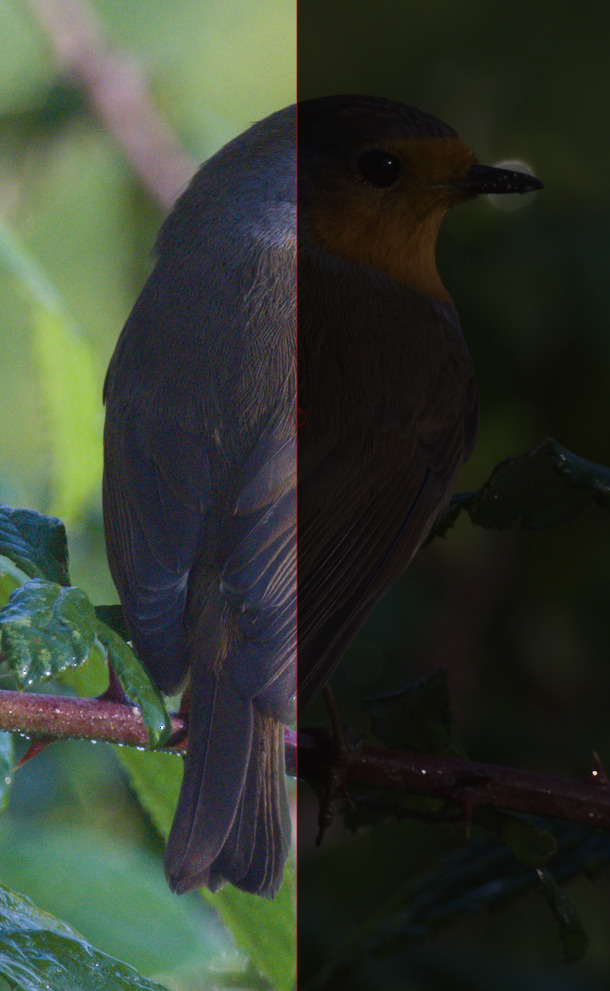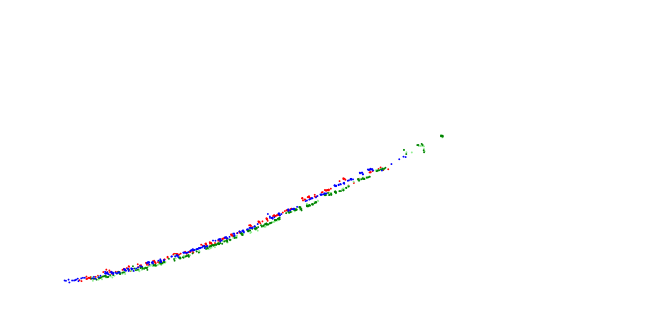On my Canon R7 this is not the case. Underexposure causes more loss of quality and increased noise than correct exposure achieved by crazy high ISO numbers. I tested this carefully yesterday. My camera is not ISO invariant.
Some interesting discussions here. Some great information and food for thought. It certainly inspired me to test my Canon R7 camera carefully for what what happens across the ISO range from 100 to 25600.
But back to my original point. I will accept noise, loss of dynamic range and any other technical trade off to avoid a shot ruined by camera shake, subject blur or being out of focus. This is especially true when taking hand held images of wildlife after the sun has set as on on my previous trip to Sri Lanka. Now if I am photographing a sunlit landscape going beyond 100 ISO may not be necessary unless I need extreme depth of field so I close the aperture down and movement caused by wind limits my slowest practical shutter speed.
The art of photography can not be measured in technicalities but the photograph can sure be destroyed by unwanted blur. When travelling my norm will still be 400 ISO, but I now have greater appreciation for why I should more often grab my tripod and shoot at the cameras lowest ISO when practical.
Thanks for all the responses so far and some of the great links supplied.
Ah OK, that was the missing piece. For some reason, I thought that everything but the ISO value (aperture, shutter speed) was unchanged, and that was somehow supposed to influence the illumination of the sensor – no wonder it did not make sense. I don’t know what led me to that thought (besides sleep deprivation). Thanks.
https://www.photonstophotos.net/Charts/RN_e.htm#Canon%20EOS%20R7_14
Yech. Looks like a gain switch every stop. Surprised to see this in a modern camera.
Also for ISO-invariant dualgain cameras, the cutin point does tend to be lower for cameras with smaller photosites (less extra capacitance needed to hit ISO100), and APS-C cameras like yours have smaller sites.
what does the curve look like for an ISO-invariant camera?
lots and lots of curves here:
Yes, that’s what I’m referring to. Lots of curves, but how do I tell, from looking at the curve, if my camera is iso-invariant?
Sorry, I’ve never been sure what “ISO-invariant” actually means technically. I’m sure there are others here that can answer your question in a flash and with considerable clarity!
ChatGPT says:
A curve that shows ISO-invariant characteristics typically appears in graphs that plot signal-to-noise ratio, dynamic range, or noise levels against ISO settings. These graphs are often used by photographers and camera reviewers to evaluate and compare the performance of different camera sensors under varying lighting conditions. Here’s how ISO-invariance is represented and interpreted through these curves:
### Signal-to-Noise Ratio or Noise Level Curves
** Non-ISO-Invariant Sensors: For cameras that are not ISO-invariant, as you increase the ISO, there’s a noticeable and proportional increase in noise. Graphs plotting noise level against ISO will show a steep upward curve as the ISO setting increases, indicating deteriorating image quality.*
** ISO-Invariant Sensors: For ISO-invariant sensors, the curve will be more flat or linear, especially in the mid to high ISO ranges. This suggests that noise increases very gradually with ISO, implying that increasing the ISO setting does not significantly impact noise levels. When you brighten an image taken at a lower ISO in post-processing, it will exhibit similar noise characteristics to an image taken at a higher ISO directly in the camera.*
### Dynamic Range Curves
** Non-ISO-Invariant Sensors: The dynamic range typically decreases more sharply with increasing ISO settings. This is because higher ISO settings inherently amplify both the signal and the noise, reducing the camera’s ability to capture the full range of light to dark in an image without losing detail.*
** ISO-Invariant Sensors: For an ISO-invariant sensor, the curve showing dynamic range against ISO settings will flatten out after a certain ISO threshold. This indicates that the dynamic range of the sensor is less affected by changes in ISO. Hence, shooting at a lower ISO and adjusting the exposure in post-processing could yield a similar dynamic range to shooting at a higher ISO.*
### Interpretation of the Curves
** A flatter curve in either noise level or dynamic range plots indicates stronger ISO-invariant characteristics. This suggests that the camera can handle post-processing adjustments to exposure without significant loss in image quality due to noise or reduced dynamic range.*
** It’s important to note that absolute performance can still vary by sensor and camera; “ISO invariance” describes relative performance across ISO settings rather than an absolute measure of quality.*
HTH
P.S. If ChatGPT is to be believed, the term “ISO-invariant” is a mis-nomer because a truly ISO-invariant “curve” would be a horizontal straight line on a graph of anything versus ISO!
I am not sure what a curve looks like but here is a sample of a bird shot on a Fuji XT-3 which was previously supplied as a Play Raw. The original exposure is so dark, but increasing the exposure slider by 4.7 stops which is equivalent is I have done the math correctly of going from 100 to 2200 ISO gives no significant noise problem. ISO is still important for the look of the JPG but with the raw file you can just crank up the exposure later or do it in the camera with no real difference.
I would love my next camera to be ISO invariant like this. Then I could pick the shutter speed needed to prevent blur and the aperture for Depth of Field and fix the exposure in the processing.
My current Canon R7 camera is not ISO invariant. So if I shot this bird at 100 ISO it would just be a complete disaster. I would need to set the ISO to 2200 and live with the consequences of increased noise.

[quote=“Terry, post:49, topic:42928”]

Um …
https://www.photonstophotos.net/Charts/ptcpng/Fujifilm%20X-T3.png
Rats!!
Go here and select the XT-3 to see the stupid axes, ![]()
I actually bumped the exposure slider +4.741 so I must have increased the ISO equivalent even more than I calculated.
Understood! I just went log(2) of (2200/100) …
The PDR curve is a straight line. I thought that read noise had to be flat too, but the Nikon D300 has a straight PDR curve but non-flat read noise. Although Bill says measuring read noise from Nikon cameras can be problematic due to some apparent automatic adjustments by the camera - Sensor Analysis Primer – Read Noise – Optical Black
This is true for Sony cameras with the exception of the “kink” at the dualgain cutin. Below that cutin point, Sony sensors (and many others, the technology is licensed from Aptina) switch in a capacitor in parallel with the photodiode which greatly increases full well capacity at the cost of increased read noise. Without that capacitor, it would not be possible to achieve ISO100.
The X-T3 being discussed also has PDR curve that is not curved/straight. Photographic Dynamic Range versus ISO Setting
Read noise is nearly flat except for the dualgain “kink” (It’s a Sony sensor after all):
https://www.photonstophotos.net/Charts/RN_e.htm#FujiFilm%20X-T3_14
Basically no more than 1/3 stop variance (within measurrement error) below the dualgain cutin point, and even less variance above the cutin point. Less than 1/3 stop of variance over a 4 stop ISO range
Note that the PTC curves (what @anon8280290 found) will always be curved, since that’s a photon transfer curve at a single ISO. Bill doesn’t publish individual PTCs for each ISO unfortunately. The one exception is the Nikon D300 where you can see that increasing ISO just decreases FWC in the last graph of Sensor Analysis Primer – Photon Transfer Curve
oops my mistake - failed to notice the “wrong” X-axis, duh!
I wonder what cameras on the market have ISO invariance. I really would love my next camera to have the feature. I bought the Canon R7 regardless because I needed the best Canon crop sensor camera I could find with high pixel density to facilitate post shooting cropping for wild life photography. At the time and possibly still the R7 fits the bill. If I didn’t have Canon lenses I may have gone for the Fuji. Full frame didn’t suit my needs unless it had crazy megapixels which would have blown the budget.
As a newbie, this is all very interesting. I don’t quite understand all of it…but I can confidently state that I don’t even know what I don’t know when it comes to the technical aspects of photography.
I’m really going to enjoy coming here and learning more.
ISO Invariance is fine, but more important (in my opinion) is, to check the base ISOs of the camera model. So, if you know you often have to shoot at high ISO values to reach the desired shutter speed, it might be worth, considering a camera with a higher second base ISO. Compare the Sony 7S3 against your Canon R7:
It would have a better value at ISO 1600 than the Canon at ISO 100 due to the second base ISO. I know, you don’t want to go FF, this is just meant as an example, what to watch out for…
I mean, just the ISO invariance doesn’t cut the slack … the camera should also have a low noise level/high DNR at the desired ISO range. ![]()
dpreview usually mentions this in their reviews (for cameras from the last 5–7 years), they even have a tool to explore it in studio images.
That’s a very interesting link, thanks!
Good point. Luckily image sensors just continue to improve over the years. One day I may go also for a full frame when I want to shoot the best wide angle lens coverage. The crop sensor is ideal for my current subjects.
